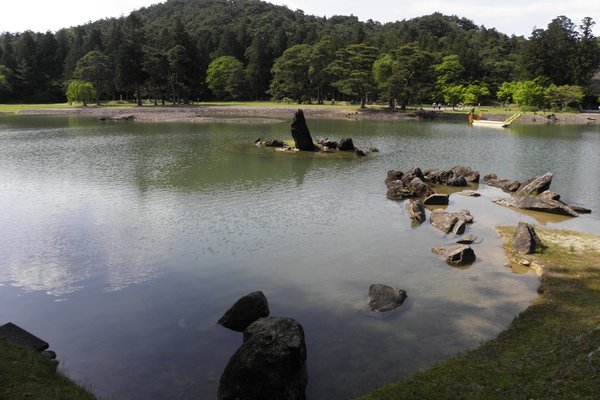Japan
Hiraizumi
Hiraizumi –Temples, Gardens, Archaeological Sites Representing the Buddhist Pure Land comprises the ensemble of four gardens and a sacred mountain that is seen as a unique and influential example of planning and garden design.
Hiraizumi blossomed as a rival to Kyoto as the political and administrative centre of northern Japan in the early 12th century. These monuments were built by the ruling clan during this short-lived period. They mix indigenous Japanese concepts of nature worship with the ideals of Pure Land Buddhism, a branch of Mahayana Buddhism.
Community Perspective: “a mix of Kyoto temples in the location of Nikko, in a region with a lack of significant cultural sites compared to other parts of Japan”. Motsuji is deemed the highlight among the inscribed locations.
Site Info
Official Information
- Full Name
- Hiraizumi-Temples, Gardens, Archaeological Sites Representing the Buddhist Pure Land (ID: 1277)
- Country
- Japan
- Status
-
Inscribed 2011
Site history
History of Hiraizumi
- 2011: Inscribed
- Inscribed
- 2008: Deferred
- Type
- Cultural
- Criteria
- ii
- vi
Links
- UNESCO
- whc.unesco.org
- Official
-
- hiraizumi.or.jp — World Heritage Hiraizumi
- Related
-
- jnto.go.jp — JNTO guide to Hiraizumi
- japan-guide.com — Hiraizumi Travel Guide
All Links
UNESCO.org
- whc.unesco.org — whc.unesco.org/
Official Website
- hiraizumi.or.jp — World Heritage Hiraizumi
Related Resources
- jnto.go.jp — JNTO guide to Hiraizumi
- japan-guide.com — Hiraizumi Travel Guide
Community Information
- Community Category
- Religious structure: Buddhist
Travel Information
Recent Connections
-
Strict no-photography policy inside
Chusonji's Konjikido - a hall completel… -
Reduced from broader TWHS
After an deferral in 2008, the number o… -
Part of Cultural nomination rejected
The Yanaginogosho Iseki (site of govern…
Connections of Hiraizumi
- Individual People
-
-
Marco Polo
"Some say that accounts of the sparkling light reflecting off the Konjiki-do led the Venetian traveller Marco Polo to describe Japan as a land so rich that all the rooves were made of gold."
-
- Trivia
-
-
Modelled after
Hiraizumi's Muryōkō-in Ato is modelled after Kyoto's Byodoin -
Dubbed as another WHS
Kyoto of the North
-
- Architecture
-
-
Gold Surfaces
Chusonji's Konjikido Hall have gold leaf covered all inside and outside the building. -
Wooden architecture
Chusonji Temple -
Japanese garden
gardens of Motsuji Temple
-
- World Heritage Process
-
-
Extensions on Tentative List
Temples, Gardens and Archaeological Sites Representing the Buddhist Pure Land (extension) -
Part of Cultural nomination rejected
The Yanaginogosho Iseki (site of government offices) was part of the nomination too, but has been rejected at inscription because it had no link with the Pure Land and had no OUV of its own. -
Reduced from broader TWHS
After an deferral in 2008, the number of designated locations shrunk from 9 to 6 (and finally to 5 inscribed).
-
- Religion and Belief
-
-
Sacred Mountains
Mount Kinkeisan -
Buddhist Pure Land
"Hiraizumi - Temples, Gardens and Archaeological Sites Representing the Buddhist Pure Land comprises five sites, including the sacred Mount Kinkeisan. The realm was based on the cosmology of Pure Land Buddhism, which spread to Japan in the 8th century. It represented the pure land of Buddha that people aspire to after death, as well as peace of mind in this life." - AB Document -
Phoenix
Hiraizumi's altar of golden Konjikido Hall is adorned with inlaid phoenix motif
-
- Human Activity
-
-
Gilded Lacquer or Urushi
the interior of Chusonji's Golden Hall is gilded and inlaid lacquer -
Mummies
Mummies of the three Fujiwara lords at Chusonji Temple
-
- Constructions
-
-
Freestanding Bell Tower
the bell towers of Chusonji and Motsuji Temples -
Mausolea
Chusonji Fujiwara Clan Mausoleum -
Protective Shelters
Protective shelter of Konjikido Hall in Chusonji Temple
-
- Timeline
- Visiting conditions
-
-
Strict no-photography policy inside
Chusonji's Konjikido - a hall completely covered in gold. Photography of the Konjikido is prohibited.
-
- WHS Names
-
-
Epic Subtitles
Temples, Gardens and Archaeological Sites Representing the Buddhist Pure Land
-
News
No news.
Recent Visitors
Visitors of Hiraizumi
- AC
- Adam Hancock
- Alex Goh
- Aspasia
- Atila Ege
- Bamse
- BaziFettehenne
- Bill Koo
- Bill Maurmann
- Casey
- Caspar
- Celina Nanbara
- chenboada
- cutecid
- cwthong
- dave wood
- Dimitar Krastev
- Els Slots
- Errol Neo
- Fan Yibo
- Frederik Dawson
- GeorgeIng61
- henrik_hannfors
- Iain Jackson
- J_neveryes
- Joel on the Road
- Jonas Kremer
- Kurt Lauer
- Lithobates
- Luis Filipe Gaspar
- Lukasz Palczewski
- Luke LOU
- MaYumin
- Michael Novins
- michaelsballard
- Mihai Dascalu
- Milan Jirasek
- Miloš Tašković
- Nafis N
- nan
- Nihal Ege
- Patrik
- Petteri
- Randi Thomsen
- Reza
- Sergio Arjona
- Shandos Cleaver
- sncjob
- Ssong.x
- Stanislaw Warwas
- Svein Elias
- Taotao Chen
- Tcchang0825
- Thomas Buechler
- Tsunami
- Vincent Cheung
- Westwards
- Wojciech Fedoruk
- Xiong Wei
- Xiquinho Silva
- Yongcheng Liu
- Zoë Sheng
Community Reviews
Show full reviews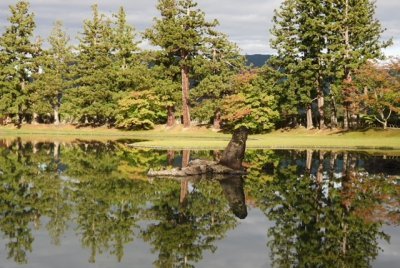
Visit date(s): October 5 & 6, 2024
Nearby sites on trip: Hiraizumi (extension)
Overnight location: Onsen near Ichinoseki
Location(s):
- Môtsû-ji
- Kanjizaiô-in Ato (photo)
- Chûson-ji
- Mount Kinkeisan
- Hiraizumi Cultural Heritage Center, on Mount Kinkeisan (There is one other site listed, but the staff at the cultural centre suggested that it wasn’t worth the trip because there wasn’t really access for visitors. Some artefacts were in the centre. There were photos of some others that are in the Tokyo national museum.)
Travel method(s): car and foot
Travel duration: Less than 15 minutes
Visit duration: 1 day total
OUV: This is difficult to fully evaluate without belonging to or studying the culture of Japanese Buddhism and Shintoism. The reconstructed gardens were certainly lovely, tranquil and meditative places. The preservation of the 12th century Konjikidô is amazing where so many wooden structures have been lost to fire.
Best of: The heavily gilded temple Konjikidô of Chûson-ji was absolutely stunning. Inside the concrete sheath, every detail has been preserved. A recording gives information about the features alternating in English and Japanese, so we could study it, then pay attention briefly before viewing some more. The gardens, though less showy, were very relaxing.
Worst of: We have no pictures of Konjikidô. Photos are not permitted. Shuffling past it was the only crowded part of the visit.
Keep reading 0 comments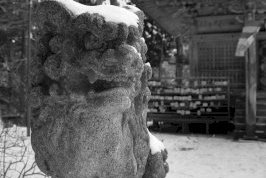
Under light snow in February 2023, I explored Chūson-ji Temple site of Hiraizumi. My introduction to the temple area was by walking through Tsukimizaka (Moon Viewing Slope), lined by well-postured cryptomeria trees. The slope leads to a slightly meandering path, which is decorated on both sides by subordinates temples and shrines.
All but three buildings at the site are reconstructions. The three surviving originals buildings are:
- the gold-leaf covered Konjiki-dō (built 1124 but restored in the 20th century);
- Konjiki-dō Ôidô (built in 15th century), which sheltered Konjiki-dō before the current concrete building; and
- Chūson-ji Kyôzô (built in 1122 with the lower storey reconstructed in the 14th century).
While one may visit the grounds for free, you must pay to visit Konjiki-dō and the museum. While Konjiki-dō is objectively a visually stunning structure, its aura is compromised by how this small building is presented. To elaborate, the allure of experiencing a building in situ is severely reduced when the said building is kept inside a concrete structure and behind glass. Looking at Konjiki-dō in this setting aroused the same emotion in me that I get when I look at an interesting artifact under a glass display in a museum. A mild, dispassionate interest.
Keep reading 0 comments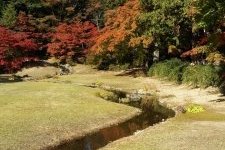
The first Japanese gardens I saw on my visit to Japan was in Hiraizumi. It takes a while to fully appreciate the artistry of a Japanese garden, so initially I felt somewhat underwhelmed. The gardens are small in scope and at first note seem random.
It was only after I had seen more of the gardens all across Japan (Kanazawa, Kyoto) that I was able to grasp that most of what I was seeing was not random nature, but planned and arranged to look natural. Back home I looked at the pictures and those from Hiraizumi stood out.
The site is spread across the city. There is one trail where there is a bear warning. The temples are fine examples and I felt that Hiraizumi was a good start on my Japan trip.
Getting There
Hiraizumi is a bit off the average travellers itinerary for Japan. But equipped with a Japan Railpass and relying on the excellent Japanese high speed rail network it's easily feasible as a relaxed day trip from Tokyo (Ueno). In Hiraizumi itself you can do everything on foot.
On Japanese Gardens
While Hiraizumi is a great garden, the best garden I have seen was in Kanazawa (Kenrokuen). I really hope the Japanese will submit it eventually. Apparently, Japanse list the following three as the best landscape gardens:
Keep reading 0 comments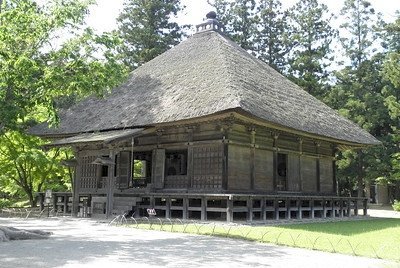
I started my visit to Hiraizumi with a smile on my face after the friendly welcome at Hiraizumi railway station: the seats are heated at the public toilets, there are coin lockers to get rid of any unnecessary luggage and there is the tourist information which hands out all kinds of folders and maps in English. I needed it after having been on a crowded train from Tokyo sandwiched between a fat older man and a sleeping salaryman.
And then I headed off into town – a very prosperous-looking town that is, just as Frederik noticed below. It’s about a 10-minute walk to the first of the 5 inscribed locations: Motsuji Temple. This is mainly known for its garden, a large landscape garden centered around a lake. I was blessed by great weather, which added to the fine composition. I also loved the building with the thatched roof at Motsu-ji.
I had read in the AB evaluation that “visual links between sites are compromised”. It sounded like overreacting to me to lament about electricity poles, but I was annoyed also when one of those kept showing up in my photos of Kanjizaiô-in Ato. This is a smaller pond, close to Motsu temple. After visiting the world heritage center, which has some interesting displays, I climbed up to Mount Kinkei. This “sacred mountain” fortunately isn’t even 100m high. There’s not a lot to see, which is also the case at Muryôkô-in Ato: an archeological field on the other side …
Keep reading 0 comments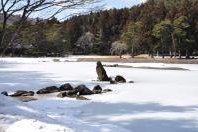
Located in the Tohoku or Northern Japan that severely suffered from earthquake and tsunami in 2011, Hiraizumi was selected as a World Heritage Site, since then the government used the inscription as the symbol of hope of this region. From Matsushima, a beautiful bay near Sendai which was hit by tsunami, I took a train to Hiraizumi. After kept my luggage in the coin-storage, I walked from the very lovely train station to Motsu-ji Temple. The town itself looked very clean and new, hard to believe its status as historic town, I thought this was the result of World Heritage Site beautification process. After short nice walked I was at Kanjizaio-in, the temple ruin was actually a large lawn with some trees and bushes around a pond, a fine place but nothing remarkable.
Motsuji Temple was my next destination, as I visited in March, this ancient garden turned to be the ice rink! However, the garden was lovely and photogenic with stones and pebbles around the pond similar to many Zen gardens in Kyoto, the most important part of the garden was the standing rock, if you saw some old photograph, you may notice that the rock had been changed its position! Then I took the bus to Chusonji Temple, the bus system of Hiraizumi was really well designed for tourists, there was a loop line called Run Run Line (pronounce like “ruin ruin” and be careful there is another bus line called Ran Ran Line that connect …
Keep reading 0 comments
